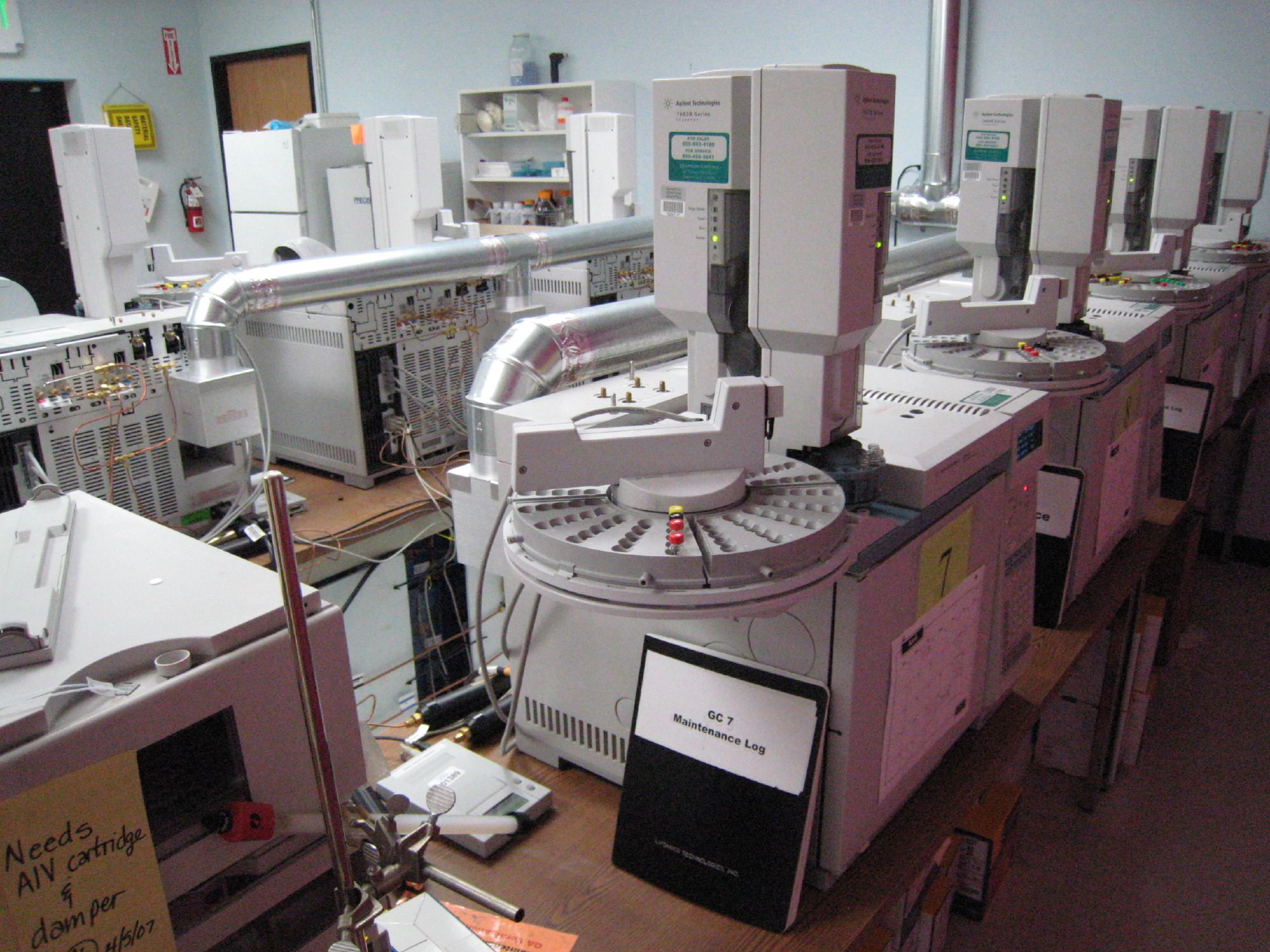Table Of Contentsorganic Chemistry Lab Techniques
General Guidelines
- Basic Chemistry Lab Techniques
- Organic Chemistry Lab Report Example
- Laboratory Techniques In Organic Chemistry
- Organic Chemistry Lab Techniques Pdf
- Use only a bound notebook and always write directly into your lab notebook. Do not write on separate scraps of paper to be added later. This means making sure you always have your notebook when you are in lab.
- Write legibly using black permanent ink only. Do not use pencil. Ball-point pens are recommended as they do not smear as easily.
- Correct mistakes by drawing a single line
throughthe error. Do not erase, white-out, or scribble out mistakes. Do not remove pages from your notebook. - Include a table of contents at the front of the notebook. Either use the inside flap or the first couple of pages to accommodate a TOC.
- Use only the front side of each page. Do not write on the back of each page.
- Use past tense and write in 3rd person to describe what you did. Your entries should indicate what you did in the past, not what you plan to do.
- You can set up your lab notebook for an experiment ahead of lab, but be sure to record ALLEXPERIMENTAL details in the notebook DURING the time you are in lab. Do not wait to record information after the lab.
- Record what you actually did in lab. Do not simply copy your lab manual. It is especially important to make note of anything you do that is different or in addition to your lab manual instructions, such as using different amounts of a substance or doing things in a different order.
- Include all observations and measurements in your lab notebook. Always include units of measurement. These notes should include if a substance changed colors, if a reaction produced bubbles, if a process took longer than expected, the weights/volumes of substances used, etc.
- Be as detailed and descriptive as possible in all observations as well as titles and headings. For example use 'Preparation of Alum' rather than 'Chemical Synthesis”
- At the end of each lab, ask yourself, 'Can I recreate this experiment/my results with what I have written down?'
General Page Structure:
Analytical Chemistry Lab. Lab Information. Before each lab session, you should prepare by reading the lab manual and the textbook required reading. We expect you to have a good understanding of the purpose, details of the procedure, the use of all chemicals and any significant hazards, and the underlying science of the experiment when you. Search for: Table of Contents. Introduction to Chemistry. Defining Chemistry; Video: The Creation of Chemistry - The Fundamental Laws.
Basic Chemistry Lab Techniques
- Top of each page
- Date
- Experiment Title
- Name
- If you are continuing from the previous page, write “continued from p. #”
- Bottom of each page
- Page number (if the notebook is not labeled with page numbers)
- Cross out all blank space at the bottom of the last page of each experiment; start a new page for each experiment
- Sampling
Our editors will review what you’ve submitted and determine whether to revise the article.
 Join Britannica's Publishing Partner Program and our community of experts to gain a global audience for your work! Thomas R. Dulski
Join Britannica's Publishing Partner Program and our community of experts to gain a global audience for your work! Thomas R. Dulski
Sample preparation, in analytical chemistry, the processes in which a representative piece of material is extracted from a larger amount and readied for analysis. Sampling and sample preparation have a unique meaning and special importance when applied to the field of analytical chemistry. Analytical chemistry in all its diverse forms can be looked upon as a multistep endeavour with the measurement phase but one link near the end of a chain of operations. That chain begins with sampling, an essential process that underlies all subsequent work and imparts relevance to what would otherwise be a meaningless exercise.
Sampling is critically relevant everywhere that analytical chemistry has a role to play. Ambient sampling of the atmosphere is used to provide analytical data on seasonal or other trends that can be correlated with natural or societal processes. For example, the extent of the Antarctic ozone hole and its relation to fluorocarbon use were confirmed by this means. Near ground level, monitoring sites provide data for air-quality assessment, for the design of pollution-control strategies, and for regulatory enforcement. Groundwater-monitoring wells are used to sample aquifers in order to ensure water quality. Rivers and streams are sampled to track pollution from industry, agriculture, sewers, and cities. The ocean is sampled to study the carbon cycle budget for Earth, and seafloor hydrothermal vents are sampled to obtain clues about geochemistry deep in Earth’s crust.
Analytical chemistry that studies other worlds follows upon careful sampling. The Apolloastronauts who explored the Moon were trained in geological sampling. Various robotic probes have sampled Mars and Halley’s Comet for automated onboard analyses. The European Space Agency’s Huygens probe sampled the atmosphere and surface of Saturn’s moon Titan in 2005.
Back on Earth, manufactured products are sampled to ensure consumer safety; foods are sampled to assay nutrients and to monitor pesticide residues and other potentially harmful contaminants. Sampling methods are also used in connection with forensic analyses, chemical analyses in customs work, and industrial processes.
Following close upon sampling is sample preparation, the entire process whereby the sample is readied for measurement. The sample that arrives at the laboratory is commonly called the laboratory sample. This is then converted by a set of operations to the test sample, from which an analyst selects a test portion for an analytical determination. If the test portion is a particulate solid, it may be necessary to convert it to a solution. If the analyte (i.e., the species being determined) is present at low concentration, or if interfering substances are present, it may be necessary to isolate or concentrate the analyte by one or more separation and purification steps. In some cases additives are required to mask interference, or the analyte must be chemically converted to another form to facilitate its measurement.
Sampling
Organic Chemistry Lab Report Example

Laboratory Techniques In Organic Chemistry
Theory
The sampling plan is the strategy employed to represent the distribution of one or multiple analytes in the object of study. The object of study may encompass objects with only spatial dimensions, such as a mineral deposit, or it may be a dynamically changing system, such as a river, which has a temporal component. In both cases the success of the sampling plan depends upon how accurately a much larger system is represented in the microcosm of the laboratory sample.
Materials vary widely in the degree of large- and small-scale uniformity that they exhibit. It is most useful to speak of the heterogeneity of a material as a scalar function that approaches perfect homogeneity in its limit. It is also essential to speak in terms of a given analyte or suite of analytes, since some components in a material may be much more heterogeneously distributed than others.

The most comprehensive sampling theory was formulated by French chemist Pierre Gy in the second half of the 20th century. Gy defined two types of material heterogeneity: constitution heterogeneity, which is the intrinsic heterogeneity of the material’s components, and distribution heterogeneity, which is the heterogeneity that derives from the spatial mixing of the components. While this dichotomy can be usefully applied to many material types, it is best described and understood in reference to particulate solid mixtures. For example, if one considers a mixture of silt and sand to be sampled for the presence of calcium, the variation of that analyte among the silt and sand particles represents two forms of its constitution heterogeneity. The degree of uniformity in the spatial arrangement of silt and sand particles then determines the distribution heterogeneity of calcium. Appropriate grinding of such a mixture to reduce the average particle size may diminish the constitution heterogeneity, and the correct blending of such a mixture may lower its distribution heterogeneity.
Organic Chemistry Lab Techniques Pdf
Gy developed another concept that involves the likelihood that all a material’s constituents have a high and equal probability of being included in the sample. Many commonly employed sampling practices are seriously flawed in that some constituents have a zero probability of being sampled. “Grab sampling,” in which one movement of a sampling device is used to select the sample, most often falls into this category, which is called nonprobabilistic sampling. Such methods can never satisfactorily represent highly heterogeneous material. In contrast, probabilistic sampling methods are techniques in which all constituents of the material have some probability of being included. However, it is only in a correctly designed sampling plan that probabilistic sampling achieves true representation.
1-Touch Laser Photo ™ Download 30-Day Free Trial. 1-Touch Laser Photo ™ is an innovative product for converting digital photographs (BMP, JPEG, PNG or TIFF formats) into bitmap files that can be used to indelibly mark or laser engrave the image into materials such as hard wood, stone or metal to create high value products. This transforms an ordinary photograph into a professional quality. Modern digital photography goes hand in hand with post-processing software. Although today the photo editing software market offers an unlimited number of options for photographers of all levels, most of the community sticks to tried-and-true Adobe. Photo softwares 1 torrent. Crop and rotate photos, adjust lighting and color, add filters and other effects. Trim video clips, and upload them to YouTube, or other social apps. Create new videos from photos and video clips, with music, filters, and other effects. Search your collection for people, places, and things that are automatically tagged for you. Verdict: This free printing software allows you to print high-quality photos in a matter of minutes, helping you optimize your workflow and save a ton of time. It offers impressive functionality, relying on the performance offered by Epson’s professional photography printers. If you’re a lucky owner of the Epson Printer, all you need to speed up the printing process and make it super. A few years ago, photo organizing software used to be really expensive, but now you can get a decent program for a reasonable price. The most basic photo organizers will cost as little as $25 and range to about $50. More professional versions will cost between $60 and $130 but they will also provide more tools for you to work with.
